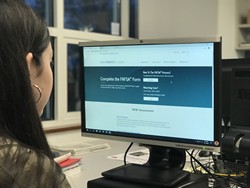According to the Institute for College Access and Success, 44.7 million American students and graduates shared a collective $1.59 trillion in educational debt in 2019.
Managing these loans may seem daunting, and understandably so. Here are some tips that might help.
First, take stock of how much in loans you’ll actually need. You don’t want to take out more debt if it might not be necessary. There are other forms of aid that don’t require you to pay back, like grants and scholarships. If you figure you can manage the tuition bill with less loans, do it.
“Look for easy scholarships from organizations in town, online, or someone you know,” said Marissa LaSala, a senior political science student. “Getting $250 to write an essay can cover a semester of books or your dorm bedding, or a month’s car payment if you decide to commute.”
Interest rates on your loans are important too. “Shop around and don’t assume that the first rate given is the best one,” said Robert Scott, Ph.D., Professor of Economics and Finance, who specializes in debt and credit markets and financial literacy. “It’s important to remember that your student loans are an investment in future income.”
Before your loans get disbursed, you sign a promissory note and complete an entrance counselling session, which will explain what you’re getting yourself into. You’ll also eventually need to complete an exit counselling session, which will discuss your responsibilities and options for repayment.
For students who transfer to another school, make sure that your lender knows that you have re-enrolled elsewhere, otherwise you will be expected to make repayments. For students continuing in graduate or professional school, repayment is often postponed while still enrolled; although some private lenders might expect in-school repayments.
Once you’ve entered a contract with your lender, which you should always read in full, it’s important to keep track of your loans and who your servicer is.
Claire Alasio, Associate Vice President for Enrollment and Director of Financial Aid, explained that this information can be found at the National Student Loan Data System (NSLDS). “When you file the FAFSA, you get an FSA ID. This FSA ID can also be used to monitor your student loan account activity,” she said.
By checking your student loan activity, you can ensure that your loans have been properly credited to your student account and that the information on your NSLDS matches the amount of loan money you accepted.
Alasio suggests checking your account at the end of each semester, and to confirm your servicer has your updated current contact information.
With an average $35,570 debt, the average monthly student loan payment will be about $296 over ten years. However, there is a six-month grace period before you are expected to make repayments. It is assumed that you will be employed by that time, something that may become easier if you’ve secured internships as a student.
“If you plan to work after college, then getting at least one internship in your field is critical,” said Scott. “The number one predictor of early employment after college graduation is whether someone had an internship or not.”
Once you enter repayment, it is imperative that you make your payments in full and on-time, or risk damaging your credit score or even defaulting if a habit of delinquent payment continues.
“If you fall behind or are having trouble in making your payments, DO NOT ignore it,” Alasio warned. “Contact your loan servicer, as there are options (deferment, forbearance, a revised repayment plan) that they may be able to help with.”
Scott advised to establish budgets, to pay off high-interest loans first, and to avoid delay; it’s never a bad idea to even get ahead on payments while still enrolled, if you can.
“You need to pay your bills, debts, etc., but you also need to think of your future,” he said. “Everyone’s financial situation is unique, so you have to consider about what makes sense to you.”
If you find yourself meeting your monthly repayments and have some extra money, Scott recommended several ways to make good investments.
“You may benefit in the long-run to pay off your student loan debt early…however, you can also choose to double-down on your retirement income and setup a Roth IRA and start contributing and investing.” He also said matching with an employer-sponsored 401k is a great investment, too.
If you ever become behind on your loans, though, or just need some guidance, contact the Financial Aid Office.
“We can’t solve the problem or pay the loan for you, but we can help to point you in the right direction,” Alasio says with assurance.
PHOTO TAKEN by Nicole Riddle




